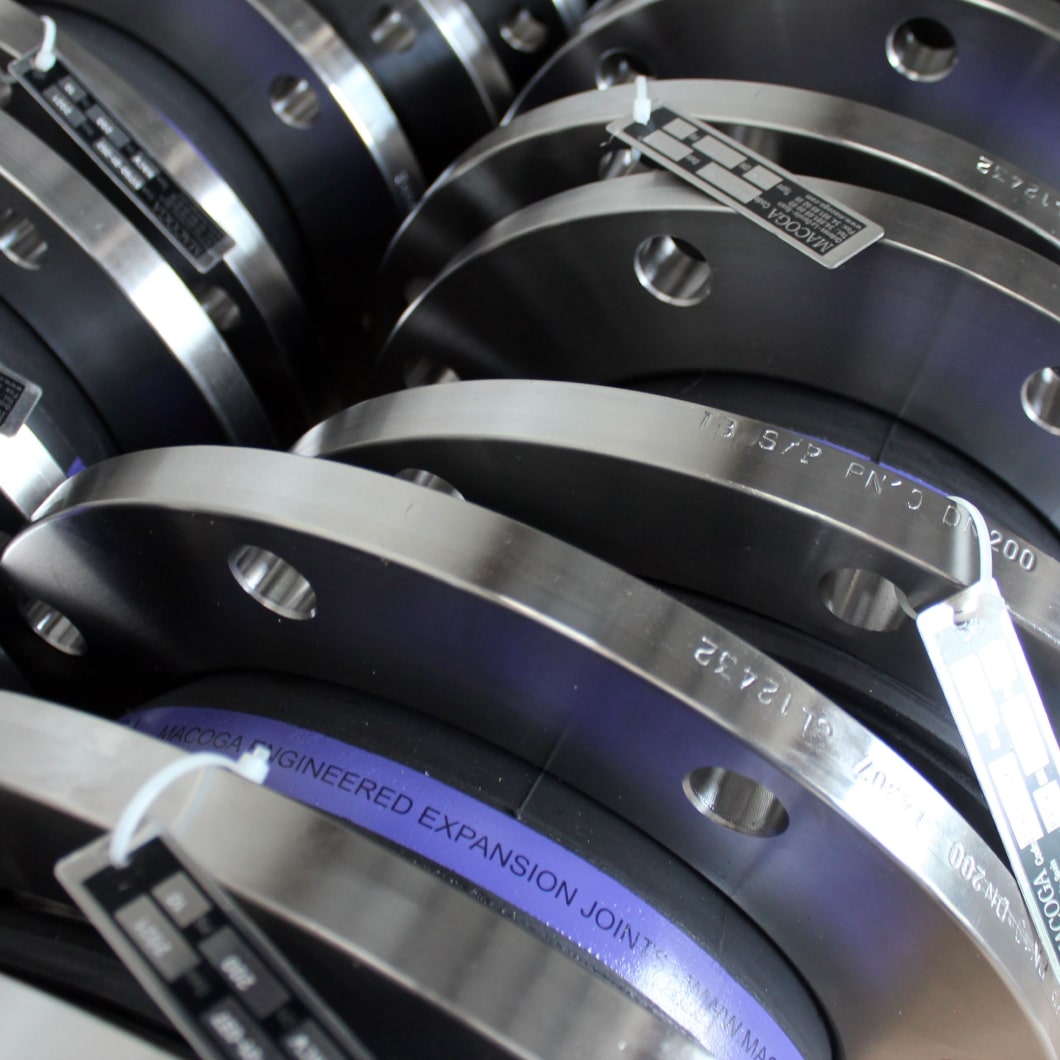| Calculation and Design Standards |
Design and calculation standards are well-established and widely recognized, often following industry standards such as EJMA (Expansion Joint Manufacturers Association), ASME (American Society of Mechanical Engineers) and European Standards. |
Design and calculation standards are available but may not be as standardized or universally accepted as those for metal expansion joints. Engineers may need to rely on manufacturer-specific data and guidelines, which can vary between suppliers. The Fluid Sealing Association handbook is a compilation of standards of construction and a guide for rubber non-metallic expansion joints. |
| Temperature Resistance |
Suitable for high-temperature applications, often exceeding 1200 °C (2190 °F). |
Limited temperature resistance, typically up to 150 °C (300 °F) or lower. |
| Pressure Resistance |
Excellent pressure resistance, suitable for high-pressure systems. |
Moderate pressure resistance, suitable for low to moderate-pressure systems. |
| Corrosion Resistance |
Good resistance to corrosion, especially when made from stainless steel and other corrosion resistance metals. |
Good corrosion resistance properties but is vulnerable to corrosion in aggressive environments. |
| Chemical Resistance |
Can be designed for specific chemical resistance but may require additional coatings or linings or special materials. |
Can be chemically resistant depending on the rubber material but may degrade over time in aggressive chemicals. PTFE lining is possible. |
| Fire Resistance |
Offers good fire resistance. |
Varies based on rubber material; may not provide fire resistance. |
| Resistance to Abrasion |
Resistant to abrasion, suitable for applications with abrasive/erosive media using right materials and/or linings. |
Vulnerable to abrasion and may wear out faster in abrasive environments. |
| Chemical Compatibility |
Can be customized for specific chemical compatibility but may require additional measures. |
Limited chemical compatibility compared to metals; may deteriorate in the presence of certain chemicals. |
| UV Resistance and Sunlight Exposure |
Resistant to UV radiation and sunlight exposure. Suitable for outdoor applications. |
Susceptible to UV radiation and sunlight exposure, may require protective measures. |
| Ozone Resistance |
Unaffected by ozone exposure. Ozone does not pose a significant threat. |
Vulnerable to ozone exposure, requiring ozone-resistant rubber in certain environments. |
| Heat Aging |
Resistant to heat aging, maintaining structural integrity at high temperatures. |
Vulnerable to heat aging, which can lead to hardening and deterioration over time. |
| Movement Absorption Capacity |
Good for absorbing axial, lateral, and angular movements. |
Excellent for absorbing axial, lateral and angular movements. |
| Flexibility |
Higher spring rates than rubber expansion joints. Provides limited flexibility compared to rubber, which may restrict movement in some cases. |
Lower spring rates. Highly flexible and capable of accommodating a wide range of movements. |
| Noise and Vibration Control |
Limited noise and vibration control capabilities. |
Excellent noise and vibration damping characteristics. |
| Shock Absorption |
Limited shock absorption capabilities. |
Excellent shock absorption properties, making them suitable for systems with frequent pressure surges or shocks. |
| Longevity |
Long service life, often exceeding 20 years or more with proper maintenance. |
Relatively shorter service life, typically 5-10 years. |
| Maintenance |
Low maintenance required, occasional inspection and tightening of bolts. |
May require more frequent inspections and replacement due to wear and tear. |
| Cost |
Typically more expensive upfront but cost-effective over the long term due to durability. |
Lower initial cost but may incur higher replacement and maintenance costs. |
| Installation |
Often requires skilled labor for welding and proper alignment. |
Easier and faster installation, suitable for various connection methods. |
| Weight |
Heavier than rubber expansion joints, which can affect structural support requirements. |
Lighter weight, which may reduce structural support needs. |
| Cleanliness and Hygiene |
Suitable for applications where cleanliness and hygiene are required selecting the right materials, cleaning procedures, specific linings, etc. |
Ideal for applications in the food, pharmaceutical and sanitary industries due to their smooth, non-porous surfaces always selecting the right internal elastomer or lining. |
| Cost of customization |
Custom designs and materials can increase costs significantly. |
Easily customizable with various rubber compounds, reducing customization costs. |
| Accessibility for site inspection |
May be challenging to inspect due to their complexity in some cases. |
Easier to inspect without the need for disassembly in most cases. |
| Compatibility with ancillary equipment |
May require additional engineering for compatibility with ancillary equipment. |
Typically more straightforward to integrate with other system components. |
| Welding and Fabrication |
Require skill welding during fabrication and generally during installation. |
Typically, no welding or fabrication skills are needed for fabrication and installation. |
| Electrical Conductivity |
Metals are good electrical conductors, so metal expansion joints can conduct electricity. This property can be an advantage or disadvantage depending on the application. |
Rubber is an insulator and does not conduct electricity, making rubber expansion joints suitable for applications where electrical conductivity is a concern. |
| Handling and Transport |
Metal expansion joints are heavier and may require special handling and transportation considerations. |
Rubber expansion joints are lighter and easier to handle and transport. |












